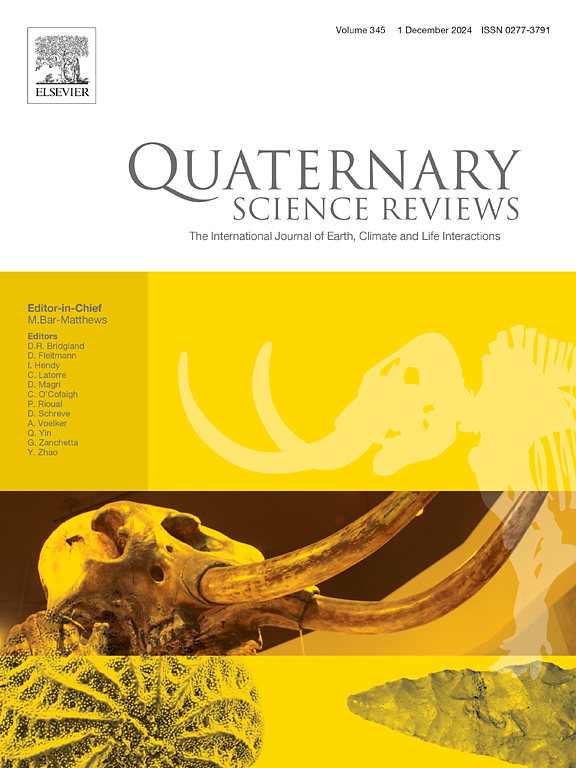德国杜文塞中石器时代活动的时间模式
IF 3.3
1区 地球科学
Q1 GEOGRAPHY, PHYSICAL
引用次数: 0
摘要
杜文西泥炭沼泽是北欧最著名的史前景观之一,在全新世早期湖泊西部边缘的小岛上有狩猎采集者的活动。优秀的有机保存,精确的挖掘和严格的放射性碳样品选择允许贝叶斯时间模型的应用。超过250个放射性碳测定结果将12个中石器时代遗址的年代定在公元前9至7千年之间。每个遗址可能只被短暂地使用过——在某些情况下可能只被使用过一季——但有些遗址在几十年甚至几个世纪的时间里被反复使用。遗址年代模型揭示了记录的中石器时代活动总体水平的急剧波动。活动强度和多样性的高峰与北方生物带开始时榛树(Corylus avellana)的快速扩张相吻合,但公元前9千年后期的活动急剧下降可能是湖泊水位变化的人工产物,而不是对植被变化、气候恶化或社会重构的反应。虽然杜文西放射性碳的结果可以解释为支持快速气候变化对人类活动产生重大影响的论点,但已知的气候事件发生时,杜文西的人类活动记录已经中断。因此,很难推断(或排除)环境因素是考古记录变化的触发因素。我们的研究结果建议将研究重点放在北方早期阶段,在这个阶段,遗址类型被保存得最广泛,可以进行考古调查。本文章由计算机程序翻译,如有差异,请以英文原文为准。

Temporal patterns in Mesolithic activity at Duvensee, Germany
The Duvensee peat bog is one of the best-known prehistoric landscapes in northern Europe, with hunter-gatherer activities located on small islands on the western edge of an Early Holocene lake. Excellent organic preservation, precise excavation, and rigorous radiocarbon sample selection permit the application of Bayesian chronological modelling. Over 250 radiocarbon results date a dozen Mesolithic sites to an extended period between the 9th and 7th millennia BCE. Each site may only have been used briefly – perhaps only for a single season in some cases – but some were used repeatedly over the course of decades or even centuries. Site chronological models reveal sharp fluctuations in the overall level of recorded Mesolithic activity. A spike in the intensity and diversity of activity coincided with the rapid expansion of hazel (Corylus avellana) at the start of the Boreal biozone, but a steep decline in dated activity in the later 9th millennium BCE may be an artefact of changes in lake level, rather than reflecting a response to vegetation change, climate deterioration or societal reconfiguration. Although the Duvensee radiocarbon results can be construed to support arguments that rapid climate change had a significant impact on human activity, known climate events occurred when the record of human occupation at Duvensee was already discontinuous. It is therefore difficult to infer (or exclude) environmental factors as triggers of changes in the archaeological record. Our results suggest focusing research on the early Boreal phase, during which the widest range of site-types is preserved and accessible for archaeological investigation.
求助全文
通过发布文献求助,成功后即可免费获取论文全文。
去求助
来源期刊

Quaternary Science Reviews
地学-地球科学综合
CiteScore
7.50
自引率
15.00%
发文量
388
审稿时长
3 months
期刊介绍:
Quaternary Science Reviews caters for all aspects of Quaternary science, and includes, for example, geology, geomorphology, geography, archaeology, soil science, palaeobotany, palaeontology, palaeoclimatology and the full range of applicable dating methods. The dividing line between what constitutes the review paper and one which contains new original data is not easy to establish, so QSR also publishes papers with new data especially if these perform a review function. All the Quaternary sciences are changing rapidly and subject to re-evaluation as the pace of discovery quickens; thus the diverse but comprehensive role of Quaternary Science Reviews keeps readers abreast of the wider issues relating to new developments in the field.
 求助内容:
求助内容: 应助结果提醒方式:
应助结果提醒方式:


